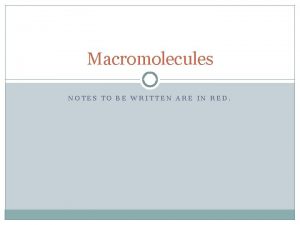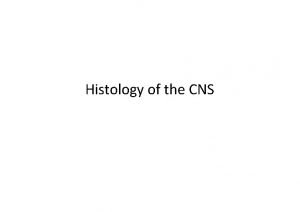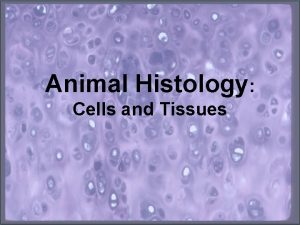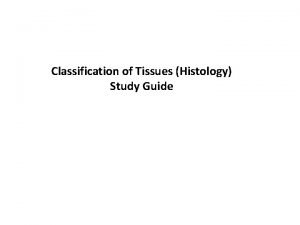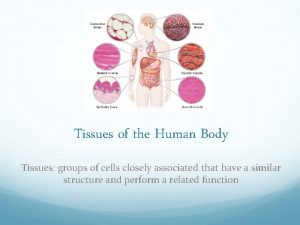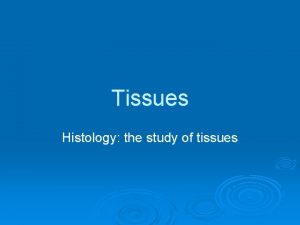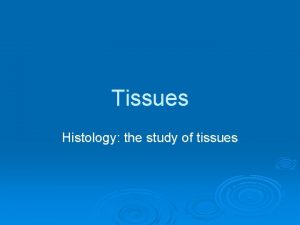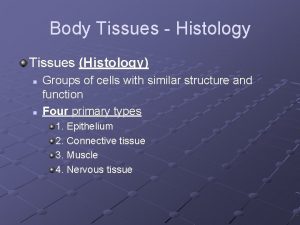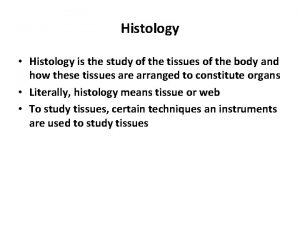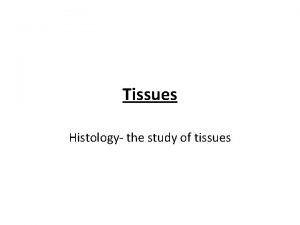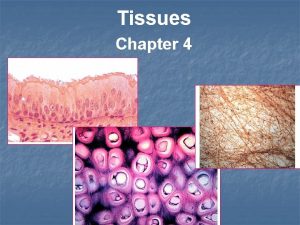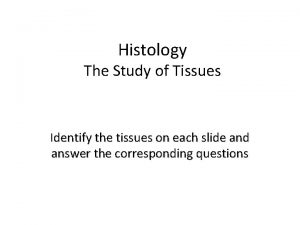Lecture 11 Animal Tissues Histology is the study











- Slides: 11

Lecture 11: Animal Tissues Histology ﻋﻠﻢ ﺍﻷﻨﺴﺠﺔ is the study of plants and animal tissues by examining ﺑﻔﺤﺺ tissues ﺍﻷﻨﺴﺠﺔ under a light microscope or an electron microscope. A tissue is a group of cells that carry out a particular function. Animals are multicellular organisms ﻛﺎﺋﻨﺎﺕ ﻋﺪﻳﺪﺓ ﺍﻟﺨﻼﻳﺎ with their specialized cells grouped into tissues. In most animals, combinations of various tissues make up functional units called organs, and groups of organs that work together are called systems. For example, the animal digestive system ﺍﻟﺠﻬﺎﺯ ﺍﻟﻬﻀﻤﻲ consists of a stomach, small intestine, large intestine, and several other organs, each comprises of different tissues.

Organs in animals are composed of different types of tissues. Each tissue is composed of cells. Level of organization ﺍﻟﺘﻌﻈﻲ in animals: Cells ﺧﻼﻳﺎ Tissues ﺃﻨﺴﺠﺔ Organs ﺃﻌﻀﺎﺀ Systems ﺃﺠﻬﺰﺓ Organism body ﺟﺴﻢ ﺍﻟﻜﺎﺋﻦ ﺍﻟﺤﻲ

Types of Animals Tissues Different types of tissues have different structures and functions. A tissue may be held by a sticky extracellular matrix ﻣﺎﺩﺓ ﺑﻴﻦ ﺧﻠﻮﻳﺔ ﻟﺰﺟﺔ that bind the cells together in a fabric of fibers (Tissue= cells + extracellular matrix). Types of tissues 1) Epithelial tissue ﺍﻟﻨﺴﻴﺞ ﺍﻟﻄﻼﺋﻲ 2) Connective tissue ﺍﻟﻨﺴﻴﺞ ﺍﻟﻀﺎﻡ 4) Nervous tissue ﺍﻟﻨﺴﻴﺞ ﺍﻟﻌﺼﺒﻲ 3) Muscular tissue ﺍﻟﻨﺴﺞ ﺍﻟﻌﻀﻠﻲ

First: Epithelial tissues ﺍﻷﻨﺴﺠﺔ ﺍﻟﻄﻼﺋﻴﺔ Characterized by ﺗﺘﻤﻴﺰ ﺑﻤﺎ ﻳﻠﻲ : 1. Cells tightly linked together. 2. The presence of a cell secretion called the basement membrane ﺍﻟﻐﺸﺎﺀ ﺍﻟﻘﺎﻋﺪﻱ 3. Covers ﻏﻄﻲ and lines ﺑﻄﻦ other tissues and organs. Functions of Epithelium Protection ﺍﻟﺤﻤﺎﻳﺔ Absorption ﺍﻻﻣﺘﺼﺎﺹ (skin) (Intestinal villi )ﺧﻤﻼﺕ Glands can be single epithelial cells, such as the goblet cells ﺍﻟﺨﻼﻳﺎ ﺍﻟﻜﺄﺴﻴﺔ that found in the stomach and intestines to secrete mucus ﺍﻟﻤﺨﺎﻁ. Multicellular glands ﺍﻟﻐﺪﺩ ﻋﺪﻳﺪﺓ ﺍﻟﺨﻼﻳﺎ include the endocrine glands ﺍﻟﻐﺪﺩ ﺍﻟﺼﻤﺎﺀ Secretion ﺍﻻﻓﺮﺍﺯ (glandular cells)

Classification of epithelial tissues Epithelia are classified by the number of cell layers and the shape of cells on the free surface. Classification based on number of cell layers: 1. Simple epithelium ﺑﺴﻴﻂ One layer of cells. 2. Stratified epithelium ﻃﺒﻘﻲ More than one layer of cells. 3. Pseudostratified epithelium ﻃﺒﻘﻲ ﻛﺎﺫﺏ One layer of cells but appear to form two layers. Classification based on cell shape: 1. Cuboidal = cube ﻣﻜﻌﺒﺔ 2. Columnar = column ﻋﻤﻮﺩﻳﺔ 3. Squamous = flat ﺣﺮﺷﻔﻴﺔ is a ﻋﻤﻮﺩﻳﺔ ﻣﻬﺪﺑﺔ ﻃﺒﻘﻴﺔ ﻛﺎﺫﺑﺔ ﺣﺮﺷﻔﻴﺔ ﻃﺒﻘﻴﺔ ﺣﺮﺷﻔﻴﺔ ﺑﺴﻴﻄﺔ ﻣﻜﻌﺒﺔ ﺑﺴﻴﻄﺔ ﻏﺸﺎﺀ ﻗﺎﻋﺪﻱ ﻋﻤﻮﺩﻳﺔ ﻃﺒﻘﻴﺔ ﻋﻤﻮﺩﻳﺔ ﺑﺴﻴﻄﺔ

Second: Connective tissues ﺍﻷﻨﺴﺠﺔ ﺍﻟﻀﺎﻣﺔ Characterized by ﺗﺘﻤﻴﺰ ﺑﻤﺎ ﻳﻠﻲ 1. Cells widely separated from each other in a matrix ﻣﺎﺩﺓ ﺧﻼﻟﻴﺔ that is produced by the cells (cells are scattered )ﻣﺒﻌﺜﺮﺓ. 2. The matrix generally consists of fibers ﺃﻠﻴﺎﻑ 3. The matrix may be solid (as in bone), gelatinous ﺟﻴﻼﺗﻴﻨﻲ , or liquid (as in blood). 4. The functions of connective tissues are to bind and support other tissues.

Types of Fibers in Connective Tissues There are three types of connective tissues fibers, which are all proteins: 1 - Collagenous fibers (white) ( ﺍﻷﻠﻴﺎﻑ ﺍﻟﻜﻮﻻﺟﻴﻨﻴﺔ )ﺍﻟﺒﻴﻀﺎﺀ Are thick and made of collagen and non-elastic ﻏﻴﺮ ﻣﺮﻧﺔ 2 - Elastic fibers (Yellow) ( ﺍﻷﻠﻴﺎﻑ ﺍﻟﻤﺮﻧﺔ )ﺍﻟﺼﻔﺮﺍﺀ Are long threads ﺧﻴﻮﻁ of elastin, which provide a rubbery quality. 3 -Reticular fibers ﺍﻷﻠﻴﺎﻑ ﺍﻟﺸﺒﻜﻴﺔ Are very thin and branched, and composed of collagen.


1 - Proper Connective Tissues ﺍﻷﻨﺴﺠﺔ ﺍﻟﻀﺎﻣﺔ ﺍﻷﺼﻴﻠﺔ A- Loose Proper Connective Tissue ﺍﻟﻨﺴﻴﺞ ﺍﻟﻀﺎﻡ ﺍﻷﺼﻴﻞ ﺍﻟﻔﺠﻮﻱ Binds epithelia to underlying tissues and functions a holding organs in place. It has all three fiber types. It has two cell types: 1 - Fibroblasts ﺧﻼﻳﺎ ﻟﻴﻔﻴﺔ Are responsible for making the extracellular fibers. 2 - Macrophages ﺧﻼﻳﺎ ﺑﻠﻌﻤﻴﺔ Are amoeboid cells ﺧﻼﻳﺎ ﺃﻤﻴﺒﻴﺔ that swallow and digest microbes, and cellular debris ﺑﻘﺎﻳﺎ ﺍﻟﺨﻼﻳﺎ ﺍﻟﻤﻴﺘﺔ by phagocytosis ﺍﻟﺒﻠﻌﻤﺔ.

B- Adipose Proper Connective Tissue ﺍﻟﻨﺴﻴﺞ ﺍﻟﻀﺎﻡ ﺍﻷﺼﻴﻞ ﺍﻟﺪﻫﻨﻲ Function as storage cells for adipose (lipids). Adipose cells ﺍﻟﺨﻼﻳﺎ ﺍﻟﺪﻫﻨﻴﺔ contain a large vacuole which in the live cell contains lipids. Cell nucleus and cytoplasm are pushed out to edge of cell membrane.

C- Fibrous Proper Connective Tissue ﺍﻟﻨﺴﻴﺞ ﺍﻟﻀﺎﻡ ﺍﻷﺼﻴﻞ ﺍﻟﻠﻴﻔﻲ It contains large number of collagenous fibers. The functions of this tissue are to attach muscles to bones (tendons )ﺍﻷﻮﺗﺎﺭ , and connect bones to other bones (ligaments )ﺍﻷﺮﺑﻄﺔ at joints ﺍﻟﻤﻔﺎﺻﻞ.
 Body tissues chapter 3 cells and tissues
Body tissues chapter 3 cells and tissues Types of tissue in the body
Types of tissue in the body Body tissues chapter 3 cells and tissues
Body tissues chapter 3 cells and tissues Cells form tissues. tissues form __________.
Cells form tissues. tissues form __________. Anatomy chapter 3 cells and tissues
Anatomy chapter 3 cells and tissues What macromolecule is a prominent part of animal tissues
What macromolecule is a prominent part of animal tissues What is the histology
What is the histology 01:640:244 lecture notes - lecture 15: plat, idah, farad
01:640:244 lecture notes - lecture 15: plat, idah, farad Animal histology
Animal histology Embryonic connective tissue
Embryonic connective tissue Specialized connective tissue
Specialized connective tissue What are the 4 types of tissues
What are the 4 types of tissues





